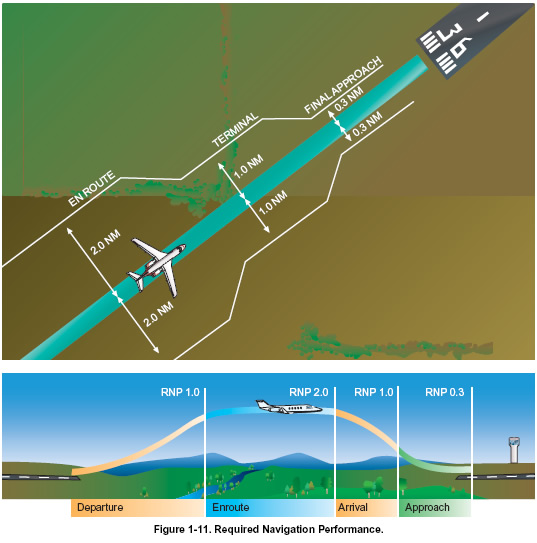 |
|
| INSTRUMENT PROCEDURES HANDBOOK |
|
REQUIRED NAVIGATION PERFORMANCE The continuing growth of aviation places increasing demands on airspace capacity and emphasizes the need for the best use of the available airspace. These factors, along with the accuracy of modern aviation navigation systems and the requirement for increased operational efficiency in terms of direct routings and track-keeping accuracy, have resulted in the concept of required navigation performance—a statement of the navigation performance accuracy necessary for operation within a defined airspace. Required Navigation Performance (RNP) is a statement of the navigation performance necessary for operation within a defined airspace. RNP includes both performance and functional requirements, and is indicated by the RNP value. The RNP value designates the lateral performance requirement associated with a procedure. [Figure 1-11]
RNP includes a navigation specification including requirements for on-board performance monitoring and alerting. These functional and performance standards allow the flight paths of participating aircraft to be both predictable and repeatable to the declared levels of accuracy. More information on RNP is contained in subsequent chapters. The term RNP is also applied as a descriptor for airspace, routes, and procedures — including departures, arrivals, and instrument approach procedures (IAPs). The descriptor can apply to a unique approach procedure or to a large region of airspace. RNP applies to navigation performance within a designated airspace, and includes the capability of both the available infrastructure (navigation aids) and the aircraft. Washington National Airport (KDCA) introduced the first RNP approach procedure in September 2005. An example of an RNP approach chart is shown in Figure 1-12.
The RNP value designates the lateral performance
requirement associated with a procedure. The required
performance is obtained through a combination of aircraft
capability and the level of service provided by the
corresponding navigation infrastructure. From a broad
perspective:
RNP 0.3 represents a distance of 0.3 nautical miles (NM) either side of a specified flight path centerline. The specific performance required on the final approach segment of an instrument approach is an example of this RNP level. For international operations, the FAA and ICAO member states have led initiatives to apply RNP concepts to oceanic routes. Here are the ICAO RNP levels supported for international operations:/p>
NOTE: Specific operational and equipment performance requirements apply for P-RNAV and B-RNAV. |

